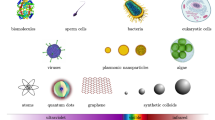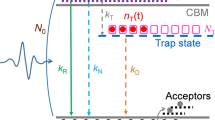Summary
In this paper the power spectrum of the «filicker noise», produced by the fluctuations of the electrical conductivity in semiconductors, thin discontinuous metal films, etc. is calculated by means of a two-parameter model. Calculations take into account that the electrical conductivity is modulated by a trapping process, using the vacancy time and the trap occupancy time as stochastic variables. By means of Machlup’s expression of the power spectrum of a two-parameter process, a new power spectrum formula is obtained under the assumption that the traps have a constant distribution law between limiting energiesE 1 andE 2. The same formula for the noise power spectrum holds even if traps have a definite energy, but access of electrons is by tunnelling and the widthsx of the potential barrier are uniformly distributed between given limitsx 1 andx 2. The present model improves the single-parameter models discussed in the literature since it accounts for the characteristics of the trapping process and removes the discrepancies involved in the preceding descriptions. Numerical calculations for different sets of values of the model parameters are also given.
Riassunto
In questo articolo si calcola lo spettro di potenza del «disturbo di tremolio», prodotto dalle fluttuazioni della conducibilità elettrica nei semiconduttori, film metallici sottili discontinui ecc., avvalendosi di un modello a due parametri. Si fanno i calcoli tenendo conto che la conducibilità elettrica è modulata da un processo di cattura, usando come variabili stocastiche il tempo di vacanza e il tempo di occupazione delle lacune. Servendosi della espressione di Machlup dello spettro di potenza di un processo a due parametri, si ottiene una nuova formula dello spettro di potenza supponendo che le trappole abbiano una legge di distribuzione costante fra le energie limitiE 1 edE 2. Vale la stessa formula per lo spettro di potenza del rumore anche se le trappole hanno un’energia definita, ma l’accesso degli elettroni avviene per effetto tunnel e le ampiezzex della barriera di potenziala sono uniformemtente distribuite fra dati limitix 1 edx 2. Questo modello migliora i modelli a parametro singolo esaminati nella produzione scientifica, dato che tiene conto delle caratteristiche del processo di cattura ed elimina i divari presenti nelle precedenti descrizioni. Si fanno anche dei calcoli numerici per diversi gruppi di valori dei parametri del modello.
Similar content being viewed by others
References
A. Mc Whorter: 1/f noise and related effects in germanium, M.I.T. Lincoln Laboratory Report, No. 80 (May 1955).
W. Shockley:Electrons and Holes in Semiconductors (New York, N. Y., 1950).
P. Mazzetti andA. Stepanescu:Thin Solid Films,13, 67 (1972).
A. Van der Ziel:Fluctuation Phenomena in Semiconductors (London, 1959).
J. H. Gisolf:Physica,15, 825 (1949).
S. Machlup:Journ. Appl. Phys.,25, 3 (1954).
Author information
Authors and Affiliations
Additional information
To speed up publication, the author of this paper has agrred to not receive the proofs for correction.
Rights and permissions
About this article
Cite this article
Stepanescu, A. 1/f noise as a two-parameter stochastic process. Nuovo Cim B 23, 356–364 (1974). https://doi.org/10.1007/BF02723642
Received:
Published:
Issue Date:
DOI: https://doi.org/10.1007/BF02723642




